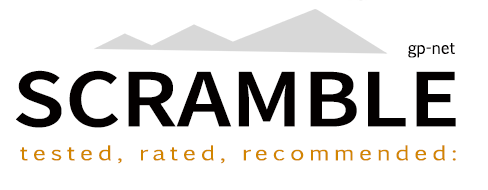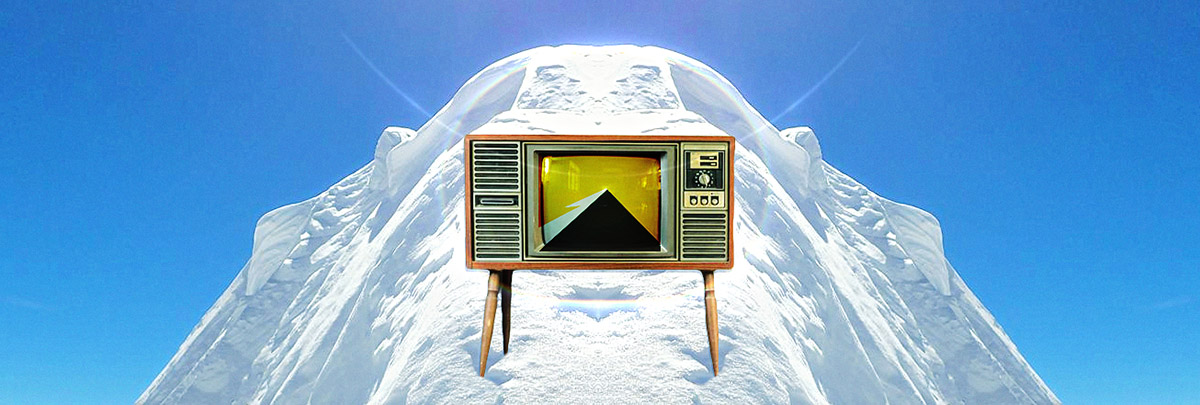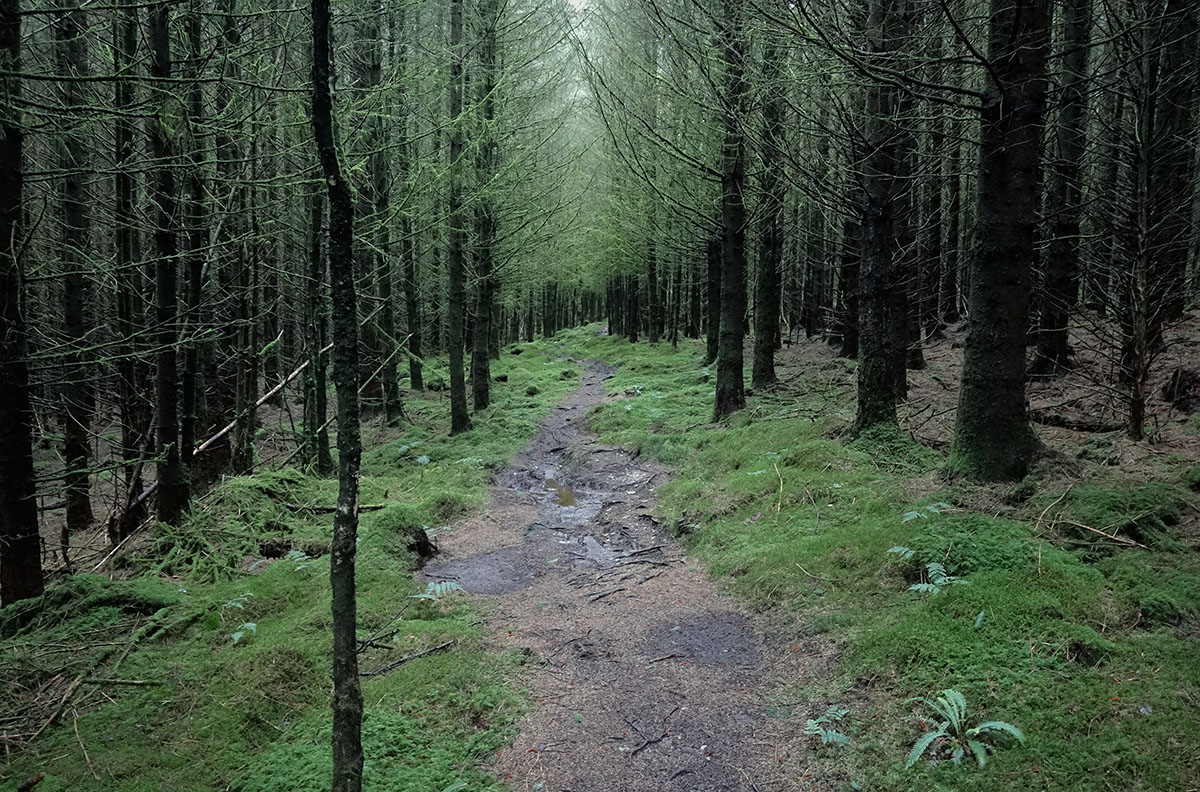2024/2025 Kit Tests (Review & Preview) + Updates
In this post we're going to run through items lined up for the upcoming 2025 spring, summer and winter kit tests, as well as mention some items of note from the 2024 summer test. But before all that, we have some manufacturing and housekeeping updates.
Contents
- Manufacturing Updates: Machine Padded Belts, Sleeping Mat Protectors & More
- Admin Updates: Categories & Kit Tests
- Upcoming Kit Test Items for 2025
- 2024: Summer Kit Test Items Reviewed
- 2024: Near Misses & Items of Note
- 2024: Summer Kit Test Snaps
Manufacturing Updates
Machine Padded Belt
We're making some minor alterations to the Machine Padded Belt following the Summer Kit Test. We've switched to a lighter EVA foam which allows us to use 6 mm on the padded side and a wrap around 3mm on the non-padded side. This is to prevent the padded component moving around the inner webbing belt. During the last kit test, it turned out that one day I'd had the belt on with the padding on the outside (so the outer had moved around the inner webbing). I didn't actually notice until the next day, which suggests the belt is reasonably comfortable without foam, but it's something we'd prefer to "stabilise" so it doesn't happen with the release version. For those waiting on these, we apologise for the delay.
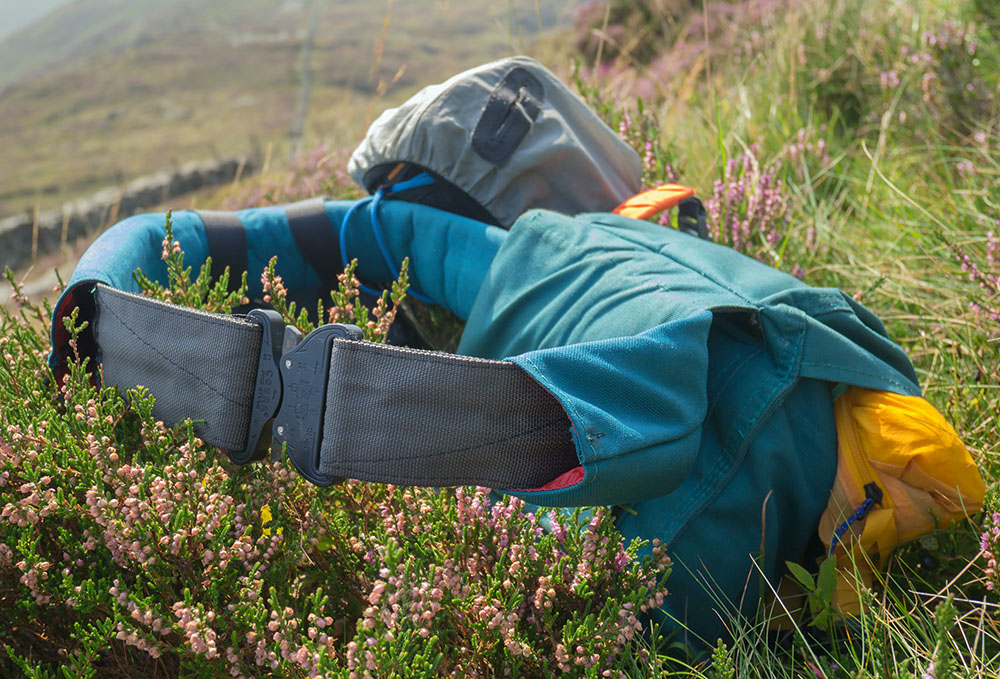 The Machine Padded Belt with Scramble's Machine Belt Bag.
The Machine Padded Belt with Scramble's Machine Belt Bag.
Tyvek Sleeping Mat Protector / Footprint / Changing Mat
Another item that has been delayed a little, this time through no fault of our own, is the Tyvek Sleeping Mat Protector (TSMP for short). We had delays sourcing one of the three tapes we use to make these.
Final tests of the prototype were completed last year and we've now received all the components for the final product.
The crazy thing about the TSMP is that the Tyvek is actually the cheapest element (compared to the multiple tapes). Each TSMP uses nearly 5m of spinnaker tape (more than a standard roll), close to 4m of Dupont's Tyvek tape and over a meter of a not inexpensive foam tape (at the "mouth" opening). Even though Tyvek is very durable, the primary reason for all this tape is to ensure there are no vulnerable edges that could initiate a tear; it also allows us to apply a stitch without creating weakness (see pic #3 below) and to insert lightweight Ecopak XPX200 "docking points" into which we can attach cord loops (see pic #2 below, circled in green) so the TSMP can be pegged down when used on sloping ground.
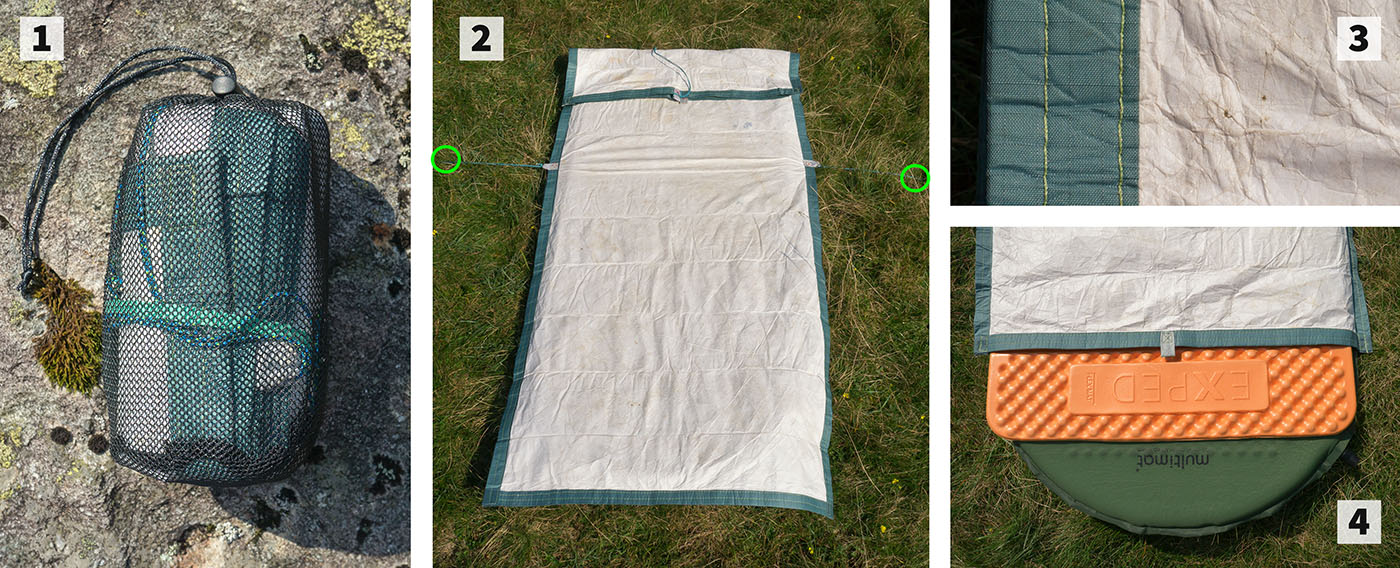 Over time these Tyvek Mat Protectors have become a staple of Scramble's kit.
Over time these Tyvek Mat Protectors have become a staple of Scramble's kit.
The TSMP is 145 x 60cm flat and can hold mats up to 140cm long. It weighs around 180g (full specs will come later) and packed into its mesh stuff sack (as pictured above #1) measures 13 (L) x 8cm (W) x 6 (D) cm. We've managed to stuff our TSMP with two self-inflating mats (25mm + 38mm thick) plus an Exped FlexMat XS (18mm thick), making its max capacity for a 50cm wide mat 8cm deep, 140cm long. Obviously, the thinner the mat(s) the more width available. So, a Sea To Summit XS Ultralight Insulated Sleeping Mat at 128 x 55 cm and 5cm thick will just about fit.
For us, the TSMP has three main roles:
- Sleeping Mat Protector
- Tent / Bivi Footprint (where the sleeping mat can be slid under the bivi so the TSMP protects the mat(s) and the floor of the bivi / tent where the user's body-weight is concentrated).
- Changing / Sit Mat (see pic below)
 After setting up shelter, the first thing unpacked is the TSMP.
After setting up shelter, the first thing unpacked is the TSMP.
The first thing I do when I've unpacked my gear (as pictured below) is unroll the TSMP, sit on it and take my boots off and get out of my (often wet) trekking clothes and into my sleepwear. Having a large surface, impervious to moisture, to sit on when the ground is often saturated, is very welcome.
The final thing that's become increasingly apparent is how the TSMP's simple "pillow case" design allows us to mix and match different mats that remain held together in a cohesive package that can then be pegged to the ground. The TSMP is fast becoming a staple of Scramble's kit, and as such we think it's ready for release.
As this is likely a niche product, we're going to initially make these on demand (we've already had some interest), so we'll probably do as we previously suggested: for each order we get, we'll make two and thus build a small stockpile as we go.
Prototyping Projects In Progress
We're working on a few investigational products for a couple of items for which we've not found satisfactory solutions elsewhere:
1. Waterproof Shorts
Another niche item, but one that for a few of us has become a regular part of our "modular" legwear approach. To date, we've been making these by butchering cheap Mountain Warehouse waterproof trousers. We decided, after much deliberation, to go ahead and make these ourselves (or at least a few prototypes), which of course allows us to employ far superiour fabrics, materials and workmanship.
We're also working on a three-quarter length version designed to be paired with (worn over) the shorts for the non-summer seasons. These are "downpour options" and in winter are designed to work alongside knee-length gaiters. If you don't wear gaiters in winter, then these wouldn't be a good option.
In spring and autumn (i.e. non-sub-zero conditions), I rarely wear gaiters and generally don't wear boots with a waterproof membrane, but have used three-quarter length waterproofs almost as a kind of "rain-skirt" option. Having them open at the hem, yet sitting below the knee, means most of the leg is sheltered but there's sufficient air-flow to reduce condensation. Being 3/4 length, there's no flapping fabric around the boot and ankle, so they don't present too much of a tripping hazard. The 3/4 versions will have a dual channel cinching mechanism, to provide a secure fit when used with gaiters for river / stream crossings or when scrambling. We'll have more to say on these once the prototypes have been through a few kit tests. Very much a work in progress at present.
2. "Return Home Shoes"
We've been looking for a very lightweight (120g max per pair) non-flip-flop shoe to wear for return journeys (when there's space in a pack to store stinky boots) and possibly around camp (though that's not really their purpose). We've not been happy with what's on offer, so we decided to make some ourselves. We've sourced the materials (6.6 nylon pack fabric, Dyneema webbing, velcro and EVA soles) and we've got an outline for the design (a kind of roman mule sandal with a slanted upper). But we're playing with two thicknesses and densities for the upper-most EVA layer.
As above, we'll provide updates / photos when we have something interesting to report.
Scramble Updates: Categories & Kit Tests
Categories
As I'm sure our readers are well aware, at Scramble we've noted that almost every advance in the outdoor industry seems to be accompanied by some form of retardation often emanating from design departments under pressure to make changes which they market as "upgrades". However, sometimes there are genuine advances (often stemming from the material sciences) which are then thoughtfully applied in well-designed products. This has happened in a couple of categories to an extent that has forced us to reconsider and ultimately redefine our expectations. As such we're going to, for the first time, alter two categories to better match the kit we're now carrying.
"Lightweight (~250g) Down Gilet" becomes "Utility Insulation Layer (Active & Static)"
Our use and subsequent Special Mention review of Marmot's Alt HB Pullover got us thinking about how we should handle our "Gilet" option which was becoming an increasingly redundant "legacy" category as it no longer accurately conveyed our approach. Recently, we've been packing less specialist, lightweight thermal layers that not only boost insulation for the static user (around camp or in a sleeping bag) but also work, in extremis, when active.
Materials like Teijin Frontier's Octa-Yarn and Primaloft's ultralight ACTIVE insulating fabric (an open synthetic plume woven through a knitted mesh) allow heat to escape when combined with an air permeable (soft) shell (or no shell at all) yet trap heat when worn under a traditional tightly woven fabric like those used in wind-tops or insulated (belay) jackets. The most promising item in this new category is OMM's 140g (L) Core Zipped Vest which is 35% lighter than the down gilet we had previously recommended and nearly 40% lighter than Marmot's Alt HB pullover which prompted the shift in our outlook.
"Ultralight (~100g) Hooded Wind Jacket" becomes "Hybrid Wind-Top & UL Waterproof Jacket"
Inspired originally by items from Black Yak and Marmot (especially Marmot's very pricey yet very good Bantamweight Anorak), the advances in genuine ultralight waterproofs has narrowed the gap between a wind-top and a waterproof to such an extent that we've increasingly been packing jackets that are nearly as light as wind-tops (~140g) but which will get you through a few hours of very heavy rain, without resorting to a full-on waterproof. In locales (such as the UK) where the weather is capricious these UL waterproof jackets are ideal. Within this category, we'll still recommend a number of traditional wind-top options (a budget, an ultralight and a fully featured), but such items will no longer be our main focus. Instead we're going to be testing jackets like OMM's Halo Smock.
Kit Tests
Perhaps it's just my paranoia, but has the US stolen our winters? I looked across the Atlantic with envy this winter (and not for the first time) while waiting for temperatures to drop toward something meaningfully and sustainably cold, but to no avail. As such, by March we decided to abandon the Winter Kit Test and as we've had to do before, switch to running a wet weather test this spring (sometime in May).
We've decided to boost our schedule and will now aim to run three kit tests per year:
- Summer (light gear / "hot" weather) kit test (~14 days)
- Spring (wet weather) kit test (~10 days), and
- Winter (sub-zero, slog & survive) kit test (~8 days)
On a partially related note ... a reader was interested in how I packed my gear, so here's my reasonably well ordered kit from last year's Summer Kit Test.
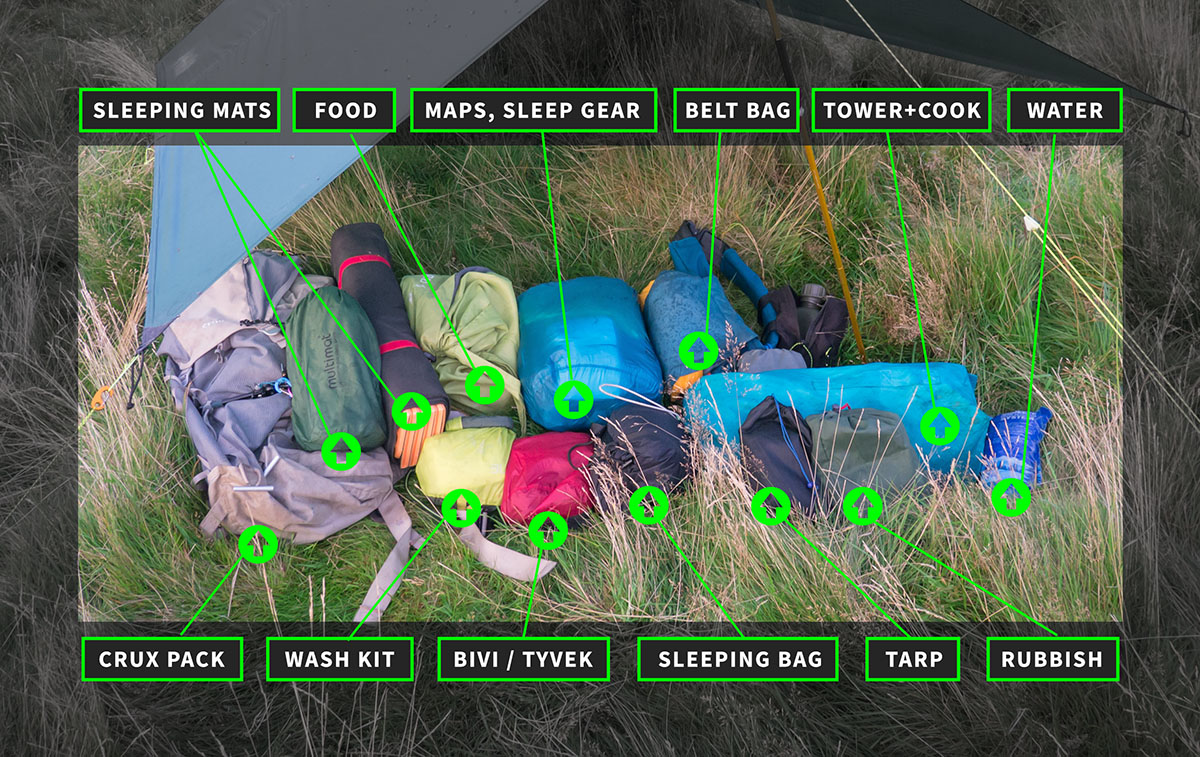 Scramble editor's pack contents.
Scramble editor's pack contents.
Upcoming Kit Test Items
- [ Midweight (~700g) Insulated Jacket ] Keela Belay Pro Jacket (Navy, M)
We'll be testing this jacket in the upcoming Winter Kit Test, not so much as a replacement for the Keela Belay Smock, but as a lighter alternative. We've come to the conclusion that for static use (which for us is what these jackets are for, as opposed to actually belaying) a hood isn't necessary (balaclava and beanie is sufficient). However, we feel the major determining factor here is body length. Our current view, is that for taller people the Belay Smock is the way to go, but for those under 6ft who want to save some weight the Belay Jacket may be a good alternative. That's what we'll be testing when it gets cold.
- [ Utility Insulation Layer (Active & Static) ] OMM Core Zipped Vest / Gilet (L, 140g)
As mentioned above, our previous "Lightweight (~250g) Down Gilet" category, is making way for ultralight boosters that will work as both active and static insulation. The OMM Core vest looks a very interesting and promising candidate.
- [ Hybrid Wind-Top & UL Waterproof Jacket ] OMM Halo Smock (L, 135g + 5g for stuff sack)
Likewise, our old "Ultralight (~100g) Hooded Wind Jacket" category is being replaced by "Hybrid Wind-Top & UL Waterproof Jacket". The OMM Halo Smock may be our first recommendation in this new category. We'll still recommend a number of traditional wind-tops (a budget, an ultralight and a fully featured), but they won't be our main focus.
- [ Lightweight (Under 400g) Softshell Jacket ] Dynafit Transalper Dynastretch (DST) Jacket (XL)
This is a very lightweight softshell which would be a challenger to Rab's Borealis jackets. Dynafit size a little smaller than Rab and Mountain Equipment, the XL fitting like the UK brands' size Large. The Dynafit is a zipped jacket with a hood and the XL weighs just 282g. Part of the reason for its light weight is the mesh back and our concern is how this holds up under a heavy pack over time. We'll see. It's certainly a quality item. It will work well as the inner for our modular softshell approach in the winter, but we'll see how it looks after it solos in our summer kit test.
- [ Lightweight (Under 400g) Softshell Jacket ] Scott Explorair Softshell SL Jacket (L)
We're always looking at possible contenders in the softshell space, as manufacturers like to discontinue lines; it's useful to know if there are genuine contenders waiting in the wings. In terms of material mix the Explorair is somewhere between the ME Echo and the Rab Tour, but its weight is greater than stated and at 358g is a little heavier than we'd like. We're going to test this as an outer for colder climes.
- [ Modular Approach: Softshell Trousers ] Rab Incline Pants, Rab Momentum Light Shorts
We're always interested to see if there aren't cheaper (yet equally effective) ways of doing things. Softshell trousers are getting, like everything else, very expensive. In terms of fabric weight, Rab's Incline "Pants" are between Mountain Equipment's Comici and Ibex trousers. On their own, they'd be fine for 3 season use. What we wanted to test is whether you could get away with combining them with some genuine, lightweight softshell "under-shorts" in winter, combined with gaiters and winter leggings. Perhaps you only need a single pair of trousers for all four seasons. That's the idea we'll be testing in the upcoming kit tests.
- [ Extremities / Accessories ]
[ Half Balaclava ] Artilect Darkhorse Neck Tube (OS)
We've been getting rather fed up with trying to deal with the Polish brand Brubeck; their items are often discontinued, out of stock, hard to source and their ability to communicate, non-existent. We think we've found a superior item from the US brand Artilect. It does the same thing, but has a better design and uses interesting materials. Looks very promising.
[ Thermal Over-Mitts ] Inov8 Extreme Thermo Mittens, Montane Chonos Fleece Mitts
Buffalo Mitts have been getting very expensive, so we're looking at a couple of lighweight alternatives.
[ Light Trekking Sock ] Darn Tough Hiker Micro Crew vs HJ Hall ProTrek HJ701 Adventure Walking Socks
When it comes to socks, we've decided to do a brand review instead of recommending an individual sock. People's feet and boot purchases will necessitate a personal / subjective fit which we can't second guess. Instead we'll simply look at Darn Tough and HJ Hall and show which socks we use / like.
[ Footwear ] Bestard Nova (Winter, Membrane) Boots, Bestard Gobi (Summer, Non-Membrane) Trek Shoes
We don't review individual shoes and boots, but rather point at what to look for. The Nova's are very similar to the Altberg Bergens but with an outdoor, non-military look. With the Gobi's we're really testing how well the Cordura fabric outer stands up to a thrashing (we generally favour leather over synthetics). We'll also be testing our Kevlar laces and may start offering them if they work well.
[ Underwear ] Various
We've got a load of half-shorts and winter baselayer leggings to test. Of these, the Löffler Midway Transtex Light Boxershorts look the most promising. They're expensive - we'll see if they're worth it.
- [ Modular Approach to a 4-Season Sleeping Mat ]
* Mountain Spring Ying 99 (UL Closed Cell) Sleeping Mat (182 x 51 x 1.7) - 110g + 10g bag
* Nordisk Ven 2.5 Self-Inflating Mat (290g+ Nordisk Stuff Sack (20g)
* LightTour Half Pad R1.5 (182g + Klymit 12g Stuff Sack + Repair Kit, Accessories)
* Scramble Ultralight Evazote (EV30) Foam Mat (Short, 60g) +
Sea To Summit XS Ultralight Insulated Sleeping Mat (375g + Air Sack 45g Stuff Sack)
We're playing around with a variety of combinations. When we've got a sensible solution we'll write it up. It's likely to include:an assortment of those with asterisks stuffed inside our Tyvek mat protector.
- [ Modular Sleeping Bag 1: ~500g 1 Season and Inner ] Cocoon Mountain Wanderer (Regular)
Since the Alpkit Cloud Cover has gained some weight (+80g) and some pounds in price point, the Cocoon Mountain Wanderer summer UL synthetic / HD liner bag looks like an interesting contender. It's warmer than the Cloud Cover by at least 2°C with an EN 13537 comfort limit rating of +8°C and as stated will add 12°C of warmth when used as a liner. So for example the Carinthia G90 + Mountain Wanderer will weigh ~1,240g and be good down to -6°C / -7°C. And when used with the Defence 4 will give you a comfort limit of -27°C with a total weight of ~2,200g. Plus, you can regularly pick these up for around £70 to £80 (we got our sample for £69 incl postage).
- [ Lightweight (<400g) ~20L Pack (+ Side Pouch) ] Mountain Hardwear UL 20L Backpack, Blue Ice Dragonfly post 2022 (18L, 210D) (380g without foam)
Perhaps Blue Ice listened to us when we warned them over cost-cutting the spine out of their Dragonfly packs, they've now beefed up the Dragonfly. We still prefer the old one, but 210D 6.6 ripstop nylon is a major improvement. The old Dragonfly had 100D sides and a hefty 420D ripstop Cordura back (and was lighter). The new ones have 210D (non-Cordura) all around. When we find time, we also want to test Mountain Hardwear's UL 20L pack.
Note: There are a number of other items in circulation being re-tested that we haven't listed above.
2024: Summer Kit Test Items Reviewed (Special Mentions)
We've tested a good number of items recently but only a few from the Summer 2024 Kit Test garnered reviews (either official or "special mentions"). The reviews are linked below:
- [ Lightweight (Under 400g) Insulated Jacket ] OMM Rotor Smock (Primaloft Aerogel Version)
- [ Sighting Wrist Compass ] Suunto's M-9 Sighting Wrist Compass
- [ Camp Light ] Lumintop EDC01
2024: Near Misses and Items of Note
We don't normally go through all the kit we've tested that didn't make the grade, and we're not going to here either, but we will mention a few items that we felt worth discussing.
Hot Weather Cap: Ronhill Air-Lite Split Cap
The Ronhill Air-Lite Split Cap was going to be our top recommendation in our Hot Weather Cap category, but for some reason Ronhill have decided to stop making split caps. In our view, Ronhill's narrow focus on runners, misses the true market for such caps, namely people who pack a load of gear and need items to pack down small; more long distance trekkers than runners. We spoke to Ronhill's Brand Director on the subject and he noted "interesting timing as we have had a few people mention the split cap recently". Probably non-runners like us, searching for a dying species (what with Mountain Equipment targeting jockeys with their redesign of the Aerofoil).
 This would have been our top pick for best hot weather cap but Ronhill decided to discontinue the item (typical!).
This would have been our top pick for best hot weather cap but Ronhill decided to discontinue the item (typical!).
Mountain Equipment's move reflects what we stated earlier:
almost every advance in the outdoor industry seems to be accompanied by some form of retardation often emanating from design departments under pressure to make changes which they market as "upgrades".
In Ronhill's case, it's more a marketing issue; suffering from an overly narrow focus. Well-designed running gear is often just what lightweight backpackers and trekkers are after. In the case of the Air-Lite Split Cap, Ronhill had made exactly the right product for the wrong audience. The search for a viable split cap continues.
Akona 2mm Low-Cut Neoprene Socks
Akona's 2mm Low-Cut Neoprene Socks are designed for snorkellers, but at just 70g (per pair, UK size 9), they make excellent 3-season camp shoes. We may do a short or special mention review on these in the future. They offer just enough thermal and underfoot protection to keep your feet toasty after your boots are packed away for the night and dull the effect of sharp and spikey hidden undergrowth treasures. Excellent, lightweight piece of kit that takes up very little space in your pack (or Tower).
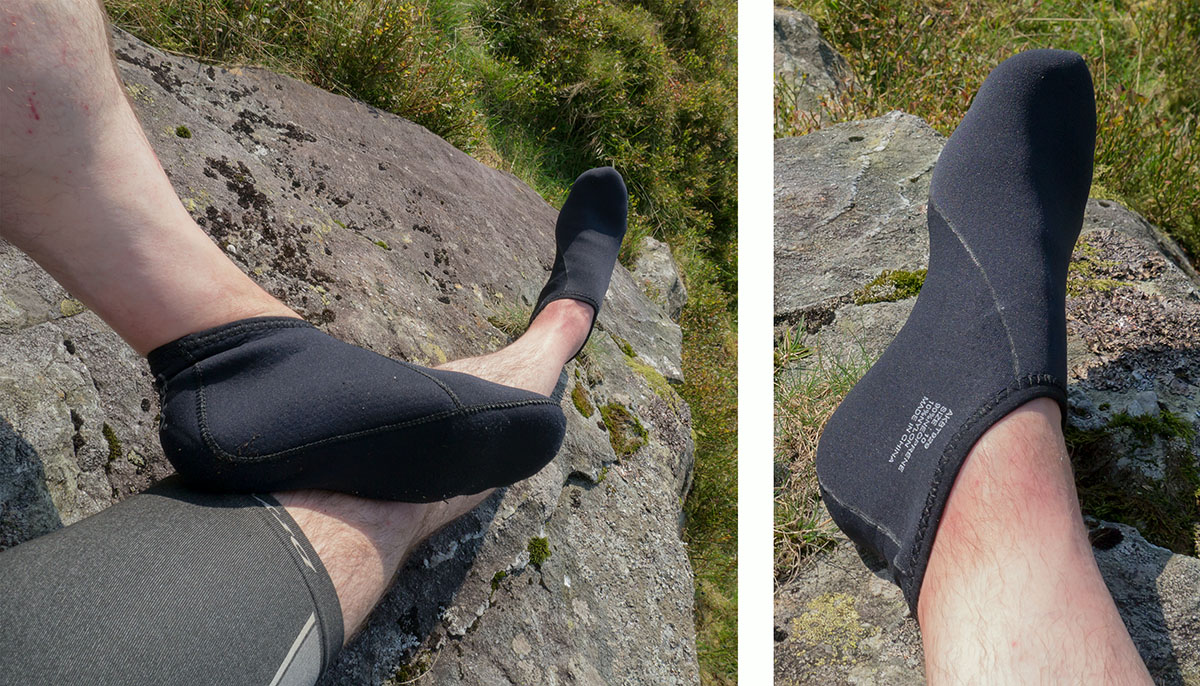 An excellent lightweight camp shoe option providing added foot protection.
An excellent lightweight camp shoe option providing added foot protection.
Tiartisans Titanium Pot 900ml (Ta8316, 150g)
As we mentioned in our review of the Keith 900ml Titanium Single Walled Pot, we'd highlight a more than capable budget option in Tiartisan's Outdoor Camping Pot 900ml (Ta8316) (Reputable Dealer Link *) which is at least £10 cheaper than the Keith pot but 30g heavier (and with a slightly heavier, though more protective stuff sack too).
* Note: We don't get any commission or financial benefit linking to third party retailers / suppliers (in case you think we've started whoring ourselves out). Instead, we just point to retailers and suppliers we've found to be trustworthy and reliable (so readers can avoid some of the headaches we've experienced while sourcing such items).
The Keith pot is more refined, the lid sits in its grooves a little more precisely and most importantly is lighter with marginally thinner walls (taking presumably less gas to boil). Tiartisans version is thicker, bulkier and not so perfectly machined, but if the Keith pot (or Alpkit's before it) didn't exist, these are not things you'd likely even notice or quibble about. The Tiartisans titanium pot is perfectly good and I had no issues with it during the 14 days of the Summer Kit Test. An excellent option if you want to save some cash and don't mind the 30g penalty.
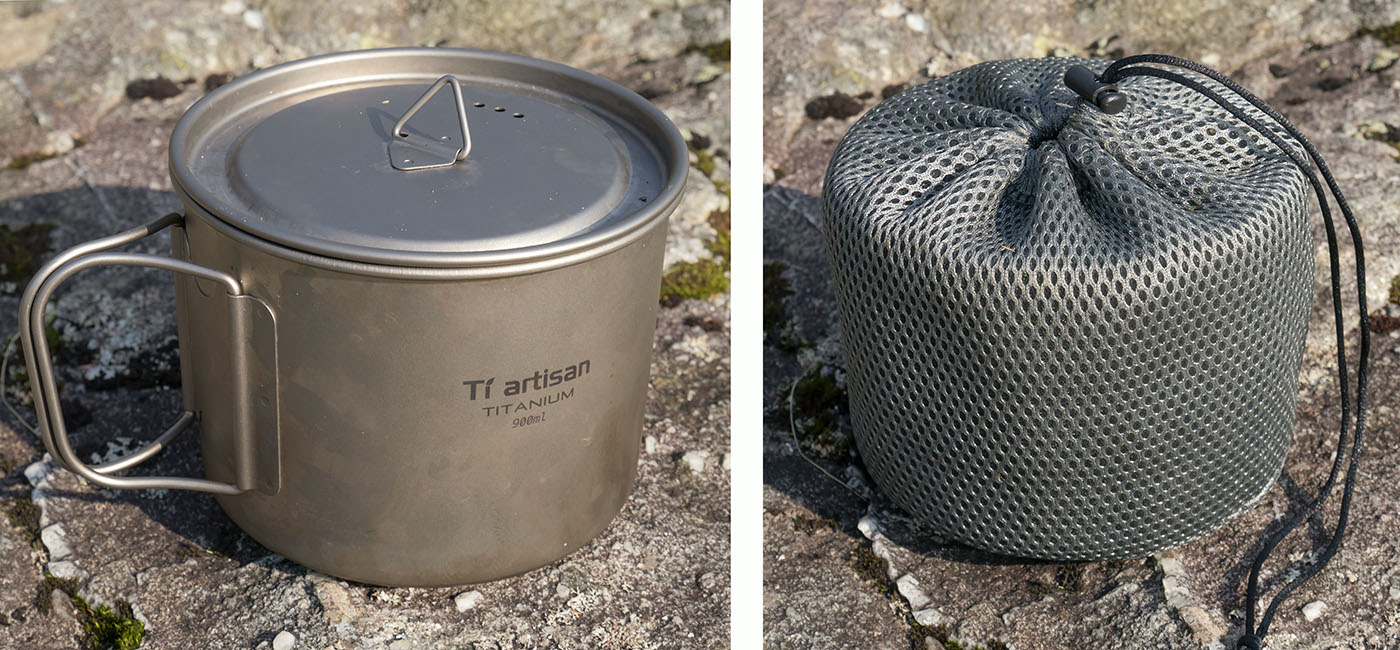 A more than capable, competitively priced titanium pot for solo trekking.
A more than capable, competitively priced titanium pot for solo trekking.
Tomshoo Titanium Bowl With Folding Handles (450ml = 70g, 550ml = 85g)
Two items that compliment the Tiartisan pot very well, making a complete and compact cookware package (pot, bowl and cup/mug) are the 450ml (S) and 550ml (M) titanium bowls by Tomshoo. These "bowls" nest inside oneanother and both fit inside the Tiartisans pot (pictured below right, with Scramble's windshield sitting inside the Tomshoo 450ml bowl / mug) . For all three items, you're looking at a total cost of around £50 (around £12 more than the Keith pot alone).
 The Tomshoo "Bowls" nest inside oneanother, but the 450ml stands out as an excellent trekking mug option.
The Tomshoo "Bowls" nest inside oneanother, but the 450ml stands out as an excellent trekking mug option.
Our recommended bowl, the Snow Peak titanium (580ml) has better ergonomics, a slightly larger capacity and is 35g lighter then the Tomshoo 550ml. The Snow Peak's sloped base makes it easier to spoon out every last bit of food and, importantly, makes it easier to clean. I pack the Snow Peak on the outside of the Keith pot and this makes Scramble's preferred cookware package a fraction more bulky in terms of packsize, but it's marginal.
Compared to Scramble's current (pot, bowl, mug) recommendations, the budget (Tomshoo, Tiartisan) combination is ~ 25g heavier (but much cheaper). However, if we substituted the heavier (stainless steel) Tatonka Expedition Mug for the Tomshoo 450ml (as our mug), then Scramble's (Keith, Snow Peak, Tomshoo combo) would weigh just 255g (70g lighter).
Although we prefer the ergonomics of the Tatonka, the Tomshoo 450ml is making a pressing case for best trek mug. It's more convenient to pack inside a pot, has a wide base which makes it very stable and the lid from your pot can sit atop the Tomshoo mug keeping your brew nice and hot for when you've finished dinner.
We'll do more testing with the Tomshoo 450ml bowl which will provide a stiff challenge to the Tatonka for our best trekking mug.
Milo Bivi Bag (Black, 385g w/o stuff sack)
Milo (aka "Milo of Climbing") have finally got themselves a website! Their bivvy was not an item seeking attention and it was almost impossible to find anything about it online, that's no longer the case. Presently, the Milo bivi is not available, but now we can actually contact them to investigate.
The Milo bivi is a little heavier than Alpkit's Hunka, largely due to its zips. The Hunka is a no-zip, corded affair, whereas the Milo uses a mid zip with two hood zips that all close at the centre (see pic #s 2 and 3 below).
If one had no other shelter, the Milo is the one you'd want (as you can pretty much seal yourself in). But, aside from being 15g heavier (without including a stuff sack, unlike the Hunka which has a convenient integrated stuff sack), it's also more expensive (the Hunka is about 30% cheaper). At present, the Hunka is still our top pick.
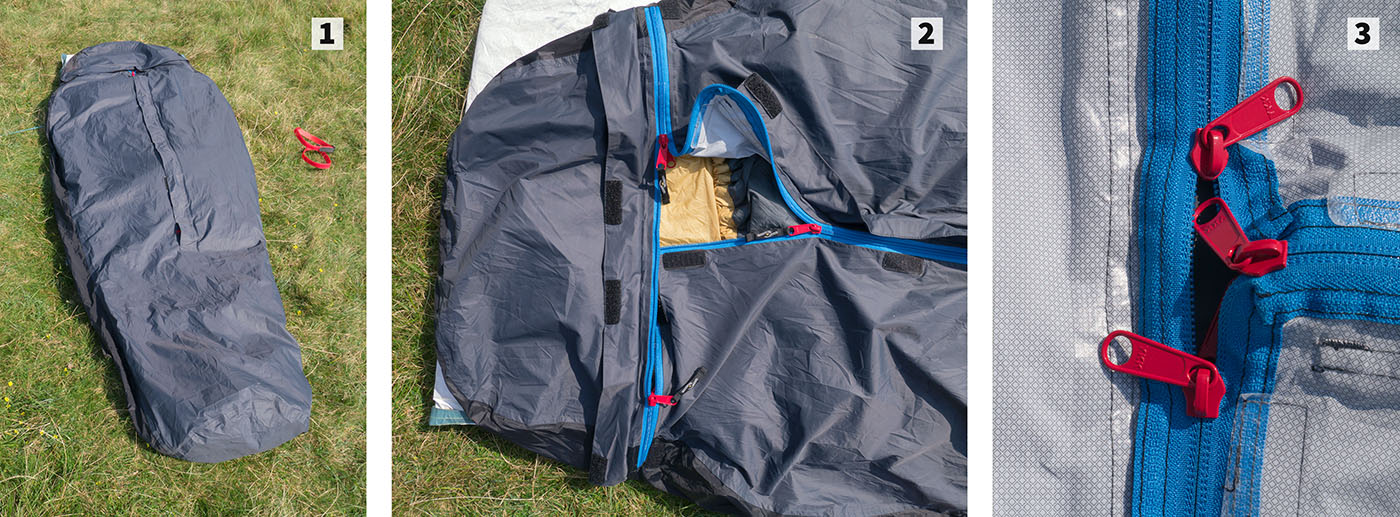 Milo's Bivi is a quality item and beats Alpkit's Hunka as a solo option, but is also more pricey.
Milo's Bivi is a quality item and beats Alpkit's Hunka as a solo option, but is also more pricey.
If we can find some time, one thing we'd like to test (perhaps with a short trip with one of the 20L day packs) is to use just the Milo bivi with Lifesystem's Ultralight 2 Person Survival Shelter (195g) to both shelter ones kit and perhaps provide some head cover for the Milo. Could make an interesting combo (~600g including stuff sacks), assuming one can ensure the wind doesn't rip the bothy out from under you. Something to experiment with for sure.
That's all the important stuff out of the way, here's some pics from the last kit test ...
2024 Summer Kit Test Snaps
Summertime and the living is .... a hard slog, a lonely tree.
Windy Rhinogs make a Michelin Man out of me.
A fast track through the forest.
The Thistle God marks an eyesore turbine for destruction.
Scramble's Summer Kit Test comes to end with a bang, not a whimper.
The End.
Last Updated: 25/04/25
